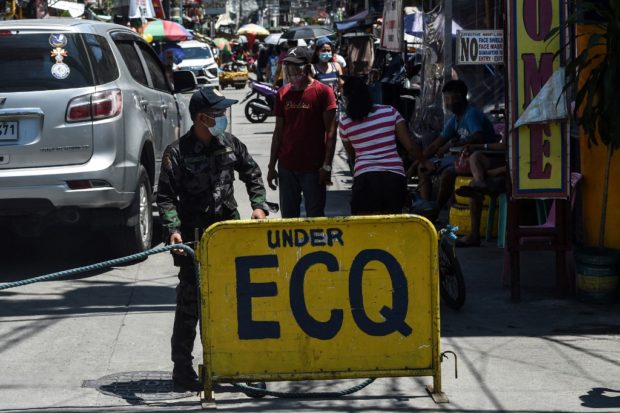What to expect during NCR pilot of granular lockdowns, new alert level system

This foreboding sign in packed Metro Manila communities will become a familiar sight again as the metropolis goes on enhanced community quarantine or ECQ from Aug. 6 to 20, 2021. (File photo from AFP)
MANILA, Philippines — Starting on Thursday, Sept. 16, the government’s COVID-19 task force will start the pilot run of granular lockdowns in Metro Manila (also known as the National Capital Region, or NCR) with the new alert levels system in a bid to suppress the number of new COVID-19 cases while preventing businesses from closing.
Malacañang earlier announced that under the new scheme only enhanced community quarantine (ECQ) or general community quarantine (GCQ) will be imposed in Metro Manila.
READ: Gov’t trims down NCR quarantine classifications to ECQ, GCQ
Under GCQ, granular lockdowns will be imposed by local government units and it will be complemented by the alert levels system which will determine the types of establishments are allowed to operate and at what capacity.
On Monday, the Inter-Agency Task Force for the Management of Emerging Infectious Diseases (IATF) released guidelines on how to implement the new strategy.
Here’s what to expect:
Granular lockdowns
Granular lockdowns will last for a period not shorter than 14 days.
Persons who may enter and exit areas under a granular lockdown are limited to health workers, uniformed personnel enforcing the restrictions, returning or outbound overseas Filipino workers, and those with emergencies.
Those delivering food and other essential items can only go up to “border collection points” designated by the LGUs.
READ: Palace: Health workers, OFWs, those with emergencies can go in and out of granular lockdowns
Residents in areas under lockdown will also receive assistance from the LGUs and the Department of Social Welfare and Development.
READ: DSWD, LGUs to distribute food packs to residents affected by granular lockdowns
Alert level system
It is the LGUs that will determine areas to be placed under granular lockdown “which may be declared regardless of Alert Level.”
The Department of Health will help identify the alert level of a pilot area, the classification of which it will do weekly unless it specifies otherwise.
Following is the description of the alert levels, with Alert Level 5 is equivalent to the old ECQ:
Alert Level 1: COVID-19 transmission in the area is low and decreasing and the total bed utilization rate, and intensive care unit utilization rates are also low.
Alert Level 2: COVID-19 transmission in the area is low and decreasing and healthcare utilization is low, or the transmission is low but increasing, and total bed utilization rate and intensive care unit utilization rates are increasing.
Alert Level 3: COVID-19 transmission and high and/or increasing and the total bed and ICU utilization rates are also increasing.
Alert Level 4: COVID-19 transmission is high and/or increasing and the total bed and ICU utilization rates are also high.
Alert Level 5: The highest alert level, refers to areas where COVID-19 transmission is alarming and the total bed and ICU utilization rates are critical.
People’s movement
Under Alert Level 4, persons aged below 18 and above 65, those with health risks, including pregnant women must stay at home unless they need to access essential goods and services or have to go to work.
Movement of persons is allowed under Alert Levels 2 and 3 with reasonable restrictions based on age and comorbidities to be determined by the LGUs which should not be stricter than those prescribed under Alert Level 4.
Regarding intrazonal and interzonal travel under Alert Levels 2 to 4, persons who are not required to stay at their homes are allowed subject to guidelines of their destination LGU.
Individual outdoor exercises are allowed in areas under Alert Level 4 for all ages regardless of comorbidities or vaccination status, but they must remain within the area of their residence.
Persons of all ages regardless of comorbidities or vaccination status are allowed to individually exercise outside in areas under Alert Level 2 and 3.
For the most lenient lockdown, or Alert Level 1, the movement of persons is allowed, but they are prohibited from engaging in activities in places that are closed, crowded, or will put them in close contact.
Gov’t work
Government agencies in areas placed under Alert Level 4 must remain fully operational while employing at least 20 percent on-site capacity with the rest under a work-from-home or flexible schedule scheme.
Those in areas under Alert Level 3 may operate at 30 percent on-site capacity and those in areas under Alert Level 2 may operate at 50 percent capacity.
Except for persons covered by granular lockdowns, all establishments, persons, or activities are allowed to operate or work at full on-site capacity in areas under Alert Level 1 provided minimum public health standards are followed.